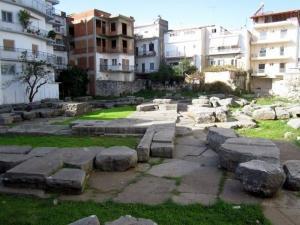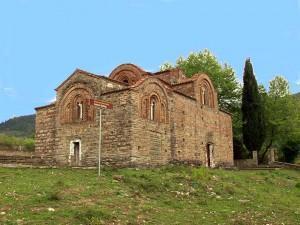Arta Prefecture Sightseeing
Here we offer a comprehensive description / guide of all sightseeing cultural attractions in the Prefecture of Arta. Classical Antiquity, Byzantine Era, Post-Byzantine Times, all have inherited a rich spectrum of monuments, all worth the inquisitive visitor's attention.
Classical Antiquity
Ambracian Walls
Ambracia is surrounded by strong fortifications of very elaborate construction. Parts of them are visible today at four different spots:
a. at the NE edge of the Metropolis Hill and the Byzantine Castle,
b. near the church of St. Mark,
c. at St. Theodoros, and
d. at the Faneromeni Monastery.
Orraon
On Castri Hill, between Ammotopos nad Gymnotopos, there is a fortified installation which has been identified as ancient Orraon. The preservation level of Orraon is impressive and rare, even second floor house-walls are preserved!
 The Apollon Temple The Apollon Temple
It is located in Arta Town downtown, on Pyrrou Street. It is dated to the early 5th century and thought to be dedicated to Apollo. It is a Doric peripteral temple (=with columns on all four sides), with a Pronaos and an oblong cella, 20,75 Χ 44 m. The foundations for the pedestal of the deity's statue are still visible. Only part of the temple remains have been found, as a result of having served as a quarry to the Christians since the Early Christian period.
The Small Theater of Ambracia
It is located in the center of ancient Ambracia. It was not built into some pre-existing hill but into an artificial mound. Its orchestra has been unearthed, also parts of its koilon (Cavea) and Parodoi, as well as of the western part of the stylobates of the proskenion. The Koilon is divided into three Cunei and was equipped with stone seats. The orchestar is circular, with a diameter of 6,70 m (20 ft). This theater was built in the end of the 4th/beginning of the 3rd centuries BC.
Southwestern Ambracian Cemetery
Along Kommenos Street there is the ancient southwestern cemetery of Ambracia, which was crossed by a large monumental avenue with grave enclosures on both of its sides. The most important grave was a cenotaph for the city's war heroes whose bodies were impossible to recover because they were lost at a sea-battle near the mouth of river Arachthos.
Byzantine Era
The Castle
Built during the rule of Michael's B', Despote of Epirus in the middle of the 13th century, the Castle is preserved in top condition. It is a monument characteristic for the secular architecture of the time and one of the most important sightseeing spots in the region.
Our Lady Parigoritissa (Mother of God the Consoling)
It was built in 1285-1289 under Nikiphoros Comnenus Ducas and his wife Anna Palaeologos-Katakouzenos. It was a huge Stavropegic Monastery of which, today, only the church, the dining hall and 16 monk cells are preserved. The church shows imposing state-of-the-art novelties both in the interior and the exterior, and the way the central cupola is supported is unique.
St. Theodora Church
This church, dedicated to saint Theodora, protectress of the city, and a pillar are the only preserved parts of the big monastery founded in the 13th century by the queen of the Despotate of Epirus in honor of S. Georgios. At that time, it functioned as a convent. After the death of her husband, Theodora entered this convent as a resident nun. She was buried there and the church was named after her.
St. Vassilios Church
A 13th century church with a very rich ceramic decorative artwork and two glazed clay icons built into its eastern wall. Manolakis Higher Greek School, named after its founder, was housed within the church's enclosure, and functioned from 1662 until 1821, when it was closed down as a retaliation measure in relation to the outbreak of the Greek National revolution against the Turkish rule.
Kato Panagia Convent
It is located on the way to Glykorizo village; it was also built during the 13th century (1250-1260) under the Despote of Epirus Michael B' Ducas. Today it is kept alive and functioning thanks to the continuous care of the resident nuns.
St. Vassilios of the Bridge
It dates from approximately 900 and is located one kilometer (0.6 mi) away from the bridge of Arta, in a region previously named Top Alt'i.
Our Lady of Vlachernae
It was founded in the beginning of the 10th century as a three-aisled vaulted basilica reconstructed to one with a dome in the middle of the 13th century. A large part of the original walls was embodied in the new church. It is located in Vlacherna, a village near Arta and was named after the church of Our Lady Vlacherna in Constantinople.
Our Lady Bryoni at Neochoraki
This church was built in 1238, was destroyed by arson in 1821, and renovated in 1870. It is dedicated to Our Lady's Dormition.
St. Demetrios Katsouri at Plisioi
The oldest monument of Byzantine Arta, built in the second half of the 9th or in the beginning of the 10th century. Renovated at the end of the 13th century, it is today preserved almost intact.
The Red Church at Voulgareli
No traces of the old monastery are preserved, but the church itself is intact. it was built in 1281, by Nikiphoros A', and is named this way due to the multitude of red plinths used to build it.
Our Lady of Coronissia at Coronissia
This is also one of the oldest churches of Byzantine Arta, dating to around the 10th century. It has at times undergone many reconstructions.
Our Lady Pantanassa (Queen of All)
Its ruins are at the north edge of the prefecture near Philippias. It was founded in the middle of the 13th century by Michael B'.
Post Byzantine Times
The Bridge of Arta
This renowned bridge, an Iconic feature for Arta, was given its final form in 1612. The foundations of the bridge, though, show that there used to be a bridge here already in Classical or Hellenistic times. The last addition took place under the Turkish rule, when the pavement was raised and the bridge was given its final contours.
Our Lady Chryssospiliotissa at Gourgiana
The church got its final form in 1663 when, most probably, some older church on the same spot was thoroughly reconstructed. Its frescoes and wood-carved Iconostasis date from 1801.
Our Lady Megalochari
It must have been built in the middle of the 17th century, replacing another pre-existing church. Megalochari village was named after this church.
Seltsou Monastery at Piges
Out of the original complex of buildings of this Monastery only the church remains intact, surrounded by ruined monk cells. The church was founded in 1697, with its frescoes and Iconostasis, and it is dedicated to Our Lady's Dormition. This monastery is of historical importance, because in 1804 more than one thousand inhabitants of Souli, a mountainous and rebellious village in Epirus, sought refuge in it while fleeing atttacking Muslim Albanians at the service of Ali Pasha, ruler of Ioannina and the rest of Epirus. After a four-month-long siege, the monastery was conquered and, in the extensive bloodshed that followed, only about fifty of the Souli fighters were saved. Women and children, to avoid being captured by the Muslims and sold as slaves, threw themselves down a 300 meter deep precipice. Tradition has it that they formed a dancing circle and started dancing and singing, carrying their infants in their arms, throwing themselves down the precipice, everyone in her turn.
St. Georgios Monastery at Voulgareli
The monastery was built in the beginning or the 18th century and is preserved in fine condition. The church is full with frescoes dating from 1714. It is here that the local Tzoumerka and Rodovyzia rebel leaders took the oath and raised the flags of the Revolution against the suppressive Turkish rule in 1821.
Our Lady of Rodia at Vigla
It is located on the bank of the estuary by the same name, near Vigla Village. The original church was demolished in 1860 to be replaced by the new one. It is dedicated to the honor of Our Lady's Dormition. It features imposing frescoes.
The Convent of Our Lady's Dormition at Skoulikaria
This is a ruined convent of which the church is preserved intact. The original convent buildings were destroyed by the Turks in 1854 and were rebuilt in 1867. What made this convent well known was the fact that one of the major rebel leaders of the Revolution against the Turkish rule in 1821, namely Georgios Karaiskakis, was born in this Convent. |



